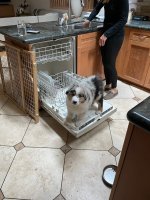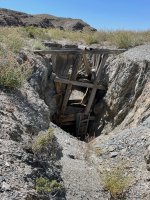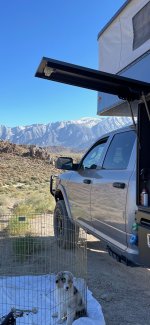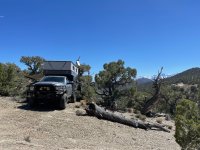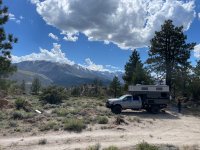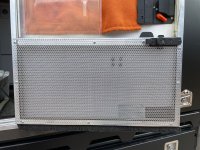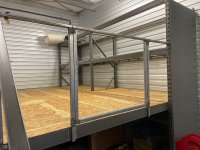Next step adding stairs.
Option A was to find some premade and pick them up in the Valley, but none were at the 10' height needed. They either under or over shot at 8' or 12'.
Option B was to use a kit that consisted of steel support beams and wood steps/risers. It would have been in the $2k range without the 2 x 6 lumber.
Option C was to buy the metal and build it myself. Including the 60 amp plasma cutter the total for materials was $1650ish...and like the pallet stacker situation, I get another useful tool that I've been wanting anyway.
Cutting sheet goods by hand using a guide for the steps and risers. 16 7.5" tall risers, 15 10" deep steps at up 3x full 4' x 8' sheets of diamond plate:

Chopping steps and risers to width using an Evolution metal cold chop saw:
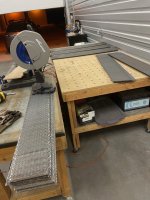
A bit (ok lots) of grinding to remove the dross (from plasma cutting) and some mill scale to prep for welding is required. It makes a bit of dust and a mess, but more takes up a lot of time.
Tacking in the first step and riser at the top:
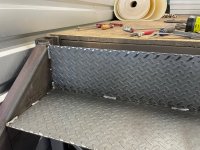
5 steps in by my first night. Hope to get the rest of the stairs and risers in by this weekend unless we opt to go on a trip:
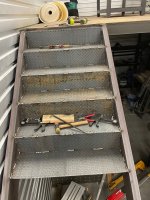
Has a bit of an issue getting that last riser in, so need to go back and adjust the trim width. You can see a small amount of bend where it is not perfectly strait.
The risers (top and bottom) reinforce and stiffen up the treads...and vice versa. Beams are C channel, 8 x 11lbs, diamond plate is 1/8". Treads boxed by the risers on each end have no deflection at all.
No, I am not a professional welder, but there will be so much bead when done that this thing will be overkill for its task. It would hold together fine with the stitch welding alone. V-notch welding uphill for penetration leaves a fair amount of crown to the weld due to it sagging under gravity. Welding down give a flatter, more attractive weld, but usually provides less penetration. I've been experimenting with both. I think going forward I'll weld down, then reinforce from the back side to ensure adequate strength. It's only time/wire/gas/electricity right?
The plan is to finish weld and clean up the stairs, then add railing to the stairs and deck. The pallet stacker reaches to 11 feet, and the deck height is 10 feet. We'll put a movable rail in the center front of the deck to lift items up onto the deck, or move them down.
More updates to follow on other things we've been doing over the past 6 months...
Option A was to find some premade and pick them up in the Valley, but none were at the 10' height needed. They either under or over shot at 8' or 12'.
Option B was to use a kit that consisted of steel support beams and wood steps/risers. It would have been in the $2k range without the 2 x 6 lumber.
Option C was to buy the metal and build it myself. Including the 60 amp plasma cutter the total for materials was $1650ish...and like the pallet stacker situation, I get another useful tool that I've been wanting anyway.
Cutting sheet goods by hand using a guide for the steps and risers. 16 7.5" tall risers, 15 10" deep steps at up 3x full 4' x 8' sheets of diamond plate:

Chopping steps and risers to width using an Evolution metal cold chop saw:

A bit (ok lots) of grinding to remove the dross (from plasma cutting) and some mill scale to prep for welding is required. It makes a bit of dust and a mess, but more takes up a lot of time.
Tacking in the first step and riser at the top:

5 steps in by my first night. Hope to get the rest of the stairs and risers in by this weekend unless we opt to go on a trip:

Has a bit of an issue getting that last riser in, so need to go back and adjust the trim width. You can see a small amount of bend where it is not perfectly strait.
The risers (top and bottom) reinforce and stiffen up the treads...and vice versa. Beams are C channel, 8 x 11lbs, diamond plate is 1/8". Treads boxed by the risers on each end have no deflection at all.
No, I am not a professional welder, but there will be so much bead when done that this thing will be overkill for its task. It would hold together fine with the stitch welding alone. V-notch welding uphill for penetration leaves a fair amount of crown to the weld due to it sagging under gravity. Welding down give a flatter, more attractive weld, but usually provides less penetration. I've been experimenting with both. I think going forward I'll weld down, then reinforce from the back side to ensure adequate strength. It's only time/wire/gas/electricity right?
The plan is to finish weld and clean up the stairs, then add railing to the stairs and deck. The pallet stacker reaches to 11 feet, and the deck height is 10 feet. We'll put a movable rail in the center front of the deck to lift items up onto the deck, or move them down.
More updates to follow on other things we've been doing over the past 6 months...






